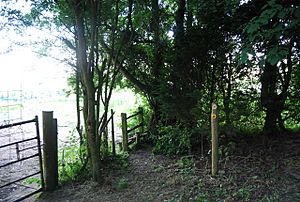Hubbard's Hill facts for kids
| Site of Special Scientific Interest | |
 |
|
| Area of Search | Kent |
|---|---|
| Interest | Geological |
| Area | 66.6 hectares (165 acres) |
| Notification | 1986 |
| Location map | Magic Map |
Hubbard's Hill is a special place located south of Sevenoaks in Kent, England. It covers about 66.6 hectares, which is roughly the size of 165 football fields! This area is protected because it's a Site of Special Scientific Interest (SSSI).
Being an SSSI means Hubbard's Hill has unique natural features. In this case, it's important for its geology, which is the study of Earth's rocks and how they formed. It's also part of the Geological Conservation Review, meaning it's one of the best places in Britain to learn about our planet's past.
Contents
What Makes Hubbard's Hill Special?
Hubbard's Hill is a fantastic outdoor classroom for understanding Earth's history. It shows us how the land has changed over thousands of years. Scientists study the rocks and soil here to learn about ancient climates and landscapes.
A Glimpse into the Ice Ages
The main reason Hubbard's Hill is so important is because of its connection to the Quaternary period. This is the most recent geological period, which started about 2.6 million years ago and continues today. It's known for its many ice ages.
How Ice and Water Shaped the Land
At Hubbard's Hill, you can see evidence of something called solifluction. This is a fancy word for how soil and loose rock move slowly down a slope. It happens when the ground freezes and thaws over and over again.
When water in the soil freezes, it expands and pushes the soil particles apart. When it thaws, the soil becomes mushy and slides downhill. This process has shaped the hills and valleys at Hubbard's Hill over a very long time.
Traces of Ancient Glaciers
Many of the deposits (layers of soil and rock) at Hubbard's Hill were formed during the Wolstonian glaciation. This was a major ice age that happened around 130,000 years ago. Imagine huge sheets of ice covering much of Britain!
Even more recently, some deposits here date back only 12,500 years. These were formed during the Younger Dryas, which was a short but very cold period. It was like a mini-ice age that happened after the main ice sheets had started to melt.
Dating the Past with Radiocarbon
Scientists can figure out how old these deposits are using a method called radiocarbon dating. This technique measures the amount of a special type of carbon (carbon-14) in ancient materials like wood or bones. It helps them create a timeline of Earth's history.
Exploring Hubbard's Hill
If you visit Hubbard's Hill, you can walk along the Greensand Way. This is a long-distance footpath that stretches for many miles. It's a great way to explore the area and see the geological features up close.

